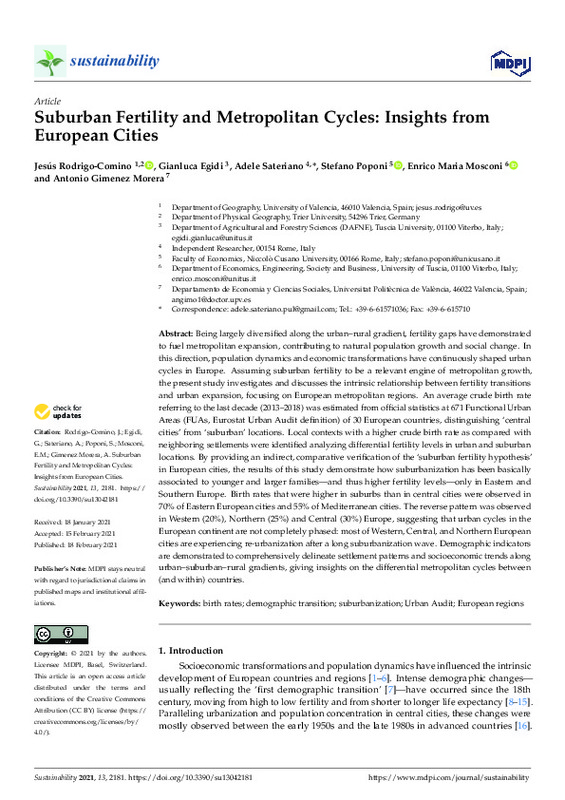JavaScript is disabled for your browser. Some features of this site may not work without it.
Buscar en RiuNet
Listar
Mi cuenta
Estadísticas
Ayuda RiuNet
Admin. UPV
Suburban Fertility and Metropolitan Cycles: Insights from European Cities
Mostrar el registro sencillo del ítem
Ficheros en el ítem
| dc.contributor.author | Rodrigo-Comino, Jesús
|
es_ES |
| dc.contributor.author | Egidi, Gianluca
|
es_ES |
| dc.contributor.author | Sateriano, Adele
|
es_ES |
| dc.contributor.author | Poponi, Stefano
|
es_ES |
| dc.contributor.author | Mosconi, Enrico Maria
|
es_ES |
| dc.contributor.author | Giménez Morera, Antonio
|
es_ES |
| dc.date.accessioned | 2022-03-23T19:03:22Z | |
| dc.date.available | 2022-03-23T19:03:22Z | |
| dc.date.issued | 2021-02 | es_ES |
| dc.identifier.uri | http://hdl.handle.net/10251/181517 | |
| dc.description.abstract | [EN] Being largely diversified along the urban-rural gradient, fertility gaps have demonstrated to fuel metropolitan expansion, contributing to natural population growth and social change. In this direction, population dynamics and economic transformations have continuously shaped urban cycles in Europe. Assuming suburban fertility to be a relevant engine of metropolitan growth, the present study investigates and discusses the intrinsic relationship between fertility transitions and urban expansion, focusing on European metropolitan regions. An average crude birth rate referring to the last decade (2013-2018) was estimated from official statistics at 671 Functional Urban Areas (FUAs, Eurostat Urban Audit definition) of 30 European countries, distinguishing 'central cities' from 'suburban' locations. Local contexts with a higher crude birth rate as compared with neighboring settlements were identified analyzing differential fertility levels in urban and suburban locations. By providing an indirect, comparative verification of the 'suburban fertility hypothesis' in European cities, the results of this study demonstrate how suburbanization has been basically associated to younger and larger families-and thus higher fertility levels-only in Eastern and Southern Europe. Birth rates that were higher in suburbs than in central cities were observed in 70% of Eastern European cities and 55% of Mediterranean cities. The reverse pattern was observed in Western (20%), Northern (25%) and Central (30%) Europe, suggesting that urban cycles in the European continent are not completely phased: most of Western, Central, and Northern European cities are experiencing re-urbanization after a long suburbanization wave. Demographic indicators are demonstrated to comprehensively delineate settlement patterns and socioeconomic trends along urban-suburban-rural gradients, giving insights on the differential metropolitan cycles between (and within) countries. | es_ES |
| dc.language | Inglés | es_ES |
| dc.publisher | MDPI AG | es_ES |
| dc.relation.ispartof | Sustainability | es_ES |
| dc.rights | Reconocimiento (by) | es_ES |
| dc.subject | Birth rates | es_ES |
| dc.subject | Demographic transition | es_ES |
| dc.subject | Suburbanization | es_ES |
| dc.subject | Urban Audit | es_ES |
| dc.subject | European regions | es_ES |
| dc.title | Suburban Fertility and Metropolitan Cycles: Insights from European Cities | es_ES |
| dc.type | Artículo | es_ES |
| dc.identifier.doi | 10.3390/su13042181 | es_ES |
| dc.rights.accessRights | Abierto | es_ES |
| dc.description.bibliographicCitation | Rodrigo-Comino, J.; Egidi, G.; Sateriano, A.; Poponi, S.; Mosconi, EM.; Giménez Morera, A. (2021). Suburban Fertility and Metropolitan Cycles: Insights from European Cities. Sustainability. 13(4):1-14. https://doi.org/10.3390/su13042181 | es_ES |
| dc.description.accrualMethod | S | es_ES |
| dc.relation.publisherversion | https://doi.org/10.3390/su13042181 | es_ES |
| dc.description.upvformatpinicio | 1 | es_ES |
| dc.description.upvformatpfin | 14 | es_ES |
| dc.type.version | info:eu-repo/semantics/publishedVersion | es_ES |
| dc.description.volume | 13 | es_ES |
| dc.description.issue | 4 | es_ES |
| dc.identifier.eissn | 2071-1050 | es_ES |
| dc.relation.pasarela | S\428993 | es_ES |








